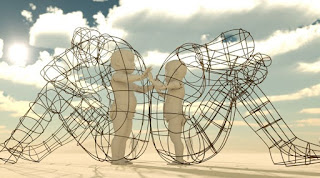“Burning Man” is a piece created by the Ukrainian
sculptor Alexandr Milov. His work consists of two wire frames of adults sitting
back to back with children reaching out toward one another trapped inside. This
piece implies that, while age and experience has taught us enough to disagree
and disconnect with others for so many various reasons, our natural desire from
when we were young was to simply connect with everyone and form bonds so that
we are not alone. This desire from our childhood has never left us, even if it
seems hard to forgive others as we get older, and we still aim to make amends
in the end, but we let our own selves get in the way of doing so.
The
children on the inside of the two adults is what really delivers the message.
It would have been one thing to have the two adults alone sitting back to back
for a reason to be interpreted, but the presence of the younger forms is enough
to express disagreement on the outside, but a want to connect on the inside.
This helps Milov attempt to tell us that, while we may argue and fail to see
eye-to-eye with others on some occasions, we still all want to try to get along
in the end, and we should let ourselves find forgiveness more easily on the
outside in order to do so. A viewer could even go as far as to say it serves as
a comfort for the effects of an argument. Yes, the two parties are upset with
one another for reasons we do not know, but they may eventually reach back out
and resolve their issues with one another because they still wish to maintain
their bonds like their inner child would want them to do.
The
adults themselves, being made of wire while the children are more solid, also
shows that while humans grow and learn, they still maintain the qualities of a
child at heart, and we do not simply lose them because of the experiences we
gain as we grow. This helps to reaffirm the point that we should be able to let
ourselves forgive those we are unhappy with, and we should not let what may be our
past experiences and thoughts get in the way of allowing relationships to
thrive.
This
work let me see my emotions in another light, and as I think about the
unconditional acceptance young children tend to have compared to the guarded
barriers an adult would put up, Alexandr Milov makes a great point on the
interactions of human beings. His choice of materials and composition especially
helped with conveying his idea.

No comments:
Post a Comment